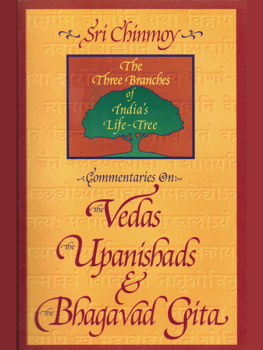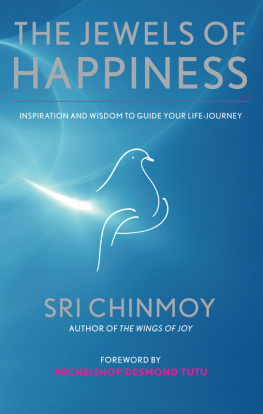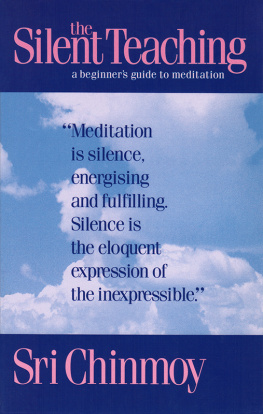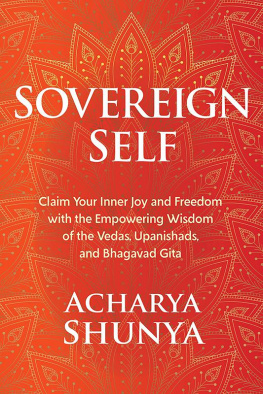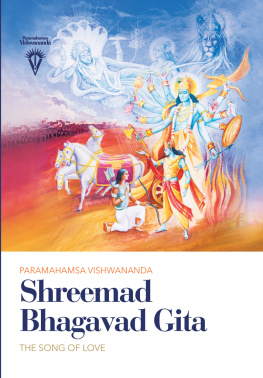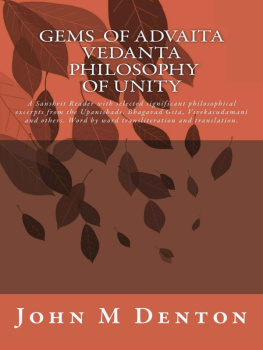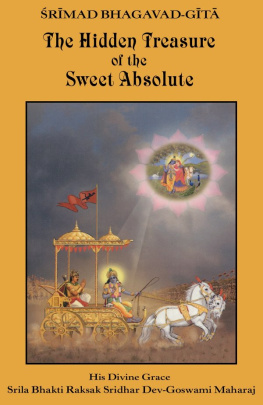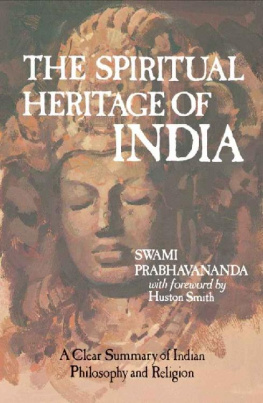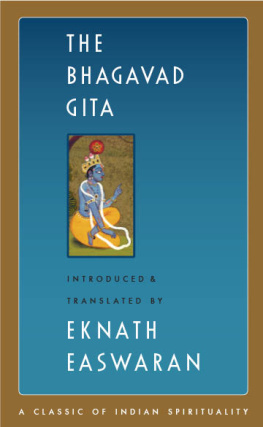Commentary on the Bhagavad Gita:
The Song of the Transcendental Soul
CONTENTS
The Vedas:
Immortalitys First Call
Sri Chinmoys first book,
Meditations, Food for the Soul,
was published in 1970.
Copyright 1996 Sri Chinmoy
Copyright 2011, 2014 Sri Chinmoy Centre (eBook)
ISBN 978-1-934972-39-7
All rights reserved. No portion
of this book may be reproduced in any form
without express written permission
from the publisher.
Published by
Aum Publications
8610 Parsons Blvd.
Jamaica, NY 11432
www.srichinmoy.org
Commentaries on the Vedas,
the Upanishads and the
Bhagavad Gita
The Three Branches of Indias Life-Tree
Sri Chinmoy
AUM PUBLICATIONS NEW YORK
The Upanishads:
The Crown of Indias Soul
The Vedas:
Immortalitys
First Call
INTRODUCTION
This volume brings together for the first time in English Sri Chinmoys commentaries on the Vedas, the Upanishads and the Bhagavad Gita, ancient Indian scriptures which are the foundation of the Hindu spiritual tradition. These talks were originally given at American universities and colleges in the early 1970s.
Sri Chinmoys approach is clear and practical, and at the same time searching and richly poetic. The book is both an excellent introduction for readers coming to this subject for the first time, and a series of illumining meditations for those who already know it well.
The Vedas
The Veda is a vast body of Sanskrit poetry, ritual treatises, dialogues and philosophical discourses which are the oldest surviving literature of India, and among the oldest literature anywhere in the world. It was composed over a period of many centuries by inspired seers, or rishis, probably (in the form we have now) beginning in the second millennium before our era. At the same time the Veda, or knowledge, is considered to have no date or human author, since the rishis did not invent but saw, in experiences of enlightenment, eternal truths which they transmitted in the form of sacred speech. The Veda is called the breath of the Supreme. Its holy words embody the same Power as that which created the universe, for the goddess Speech, the imperishable, is the first-form of Truth, mother of the Veda, the hub of Immortality.
The central religious practice of the Vedic people was the fire sacrifice, in which Agni, the fire god, was the intermediary between humans and the gods, great elemental yet also personal and spiritual forces of the cosmos. Agni is the sacrificial fire; he is in the sun and lightning and all the energies of natureand he is that Light which emerged from the abyss of the Unmanifest at the very beginning of creation. Agni is also the mounting flame within the human heart which Sri Chinmoy calls aspiration: the inner cry to transcend ourselves. Seated before the outer, ceremonial fire, the Vedic seeker contemplated the presence of the divine and invoked Agni as his own inner light to open to him the world of the gods and the mysteries of sacred speech, or mantra, which embodies in sound-form the fundamental realities of existence.
Over hundreds of years communion with the gods thus developed into an elaborate series of rituals with a fertile symbolic imagery. The hymns and incantations were sometimes devised as enigmas and might play with many levels of meaning. The symbol system of the Vedas became a key to the workings of the entire universe: visible nature, invisible realms, and the human mind, heart and soul. It was a language in which the seer-poets asked and answered the ultimate questions of life: What is the source of everything that we see and know? What is the secret of our own seeing and knowing? What is the basic pattern of all things? Who and what am I? As Sri Chinmoy has put it in this book:
A philosopher is a poet in the mind.
A poet is a philosopher in the heart.
The Upanishads
Their aspiration for understanding drew the Vedic sages at last to deep meditation on That One, the supreme Brahman or the Person, God, Who existed before the gods themselves came into being. The teachings of the ancient seers of Truth, emerging from their spiritual realisation, are most succinctly expressed in the Upanishads, the final part of the Veda. In the words of Sarvepalli Radhakrishnan:
The ideal which haunted the thinkers of the Upaniads , the ideal of mans ultimate beatitude, the perfection of knowledge , the vision of the Real in which the religious hunger of the mystic for divine vision and the philosophers ceaseless quest for truth are both satisfied is still our ideal.
The Upanishads have been the source for much of Indian philosophy, both traditional and modern, but their influence is no longer confined to India. Their brilliance and depths of intuition are always fresh, compelling and provocative. Their essential teaching is that the innermost self or soul of every living being is one with the divine. When one knows ones own true self or atman, one then also knows the highest reality and the ground of all existence. This realisation of oneness is the root of a universal love for all beings. It is reached by the practice of contemplative disciplines called yoga or union. The aim of the yoga of the Upanishads is a total self-transformation culminating in God-knowledge and God-union: He who knows Brahman becomes Brahman. As a modern seer-poet, a yogi and a knower of Brahman, Sri Chinmoy brings to his unique reflections on the meaning of the Upanishads his profound inner identification with their composers.
The Bhagavad Gita and the Age of the Epics
As the Vedic age drew to its close in the middle of the first millennium BCE, a new civilization was taking shape in India, and with it a new Hindu scripture. The Vedas were not accessible to everyone. Their sheer size and complexity, as well as their ancient symbolic language and ritual technicalities, by this time made Vedic study the work of many years. The sages who held this tradition came to feel that a new Veda was needed which would contain, in a form available to all, everything which was necessary for human life. From history and legend, from the devotions of the people and from the Vedic revelation, two great epics were created: the Mahbhrata and the Rmyaa . Both are built around the lives of great heroes and saints and the war between good and evil. The Rmyaa tells of the deeds of Prince Rama of Ayodhya, for the Hindu faith one of the human Avatars, a descent or incarnation of God. The Mahbhrata has as its core the story of five royal brothers, the Pavas , and their rivalry with their cousins for the throne of the kingdom. They are helped in their struggles by Krishna, also a hero and a king, and another of the human Avatars. Both of the epics offer a vision of dharma, the right order of human life, along with teachings and abundant examples of how this vision can be manifested through right action.
The Mahbhrata contains the Bhagavad Gita or Song of the Lord, the teachings of Krishna given to his intimate friend and disciple Arjuna as the great battle climaxing the epic is about to begin. It is the best known of all Indian scriptures, and as Sri Chinmoy says, the common property of all humanity. Countless seekers have found in the Gita not only inspiration and consolation, but also lucidly stated spiritual principles which they can apply in every inner and outer situation. Life is indeed a battle like the one Arjuna faces, and indeed Krishna teaches the way this battle can be faced, fought and won. Sri Chinmoys commentary explains how and why. The teaching of the Bhagavad Gita is love, devotion and surrender, and the dynamic yoga of action which is possible only when we live in love. It is, in essence, Sri Chinmoys own teaching as wellancient, modern and eternal.

